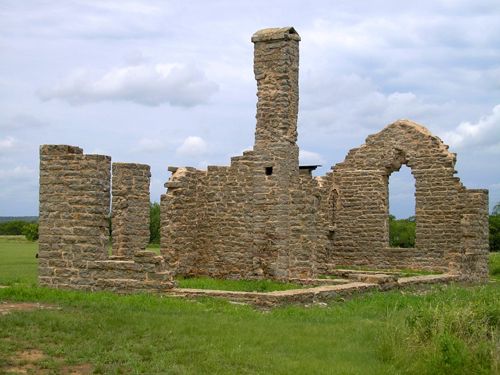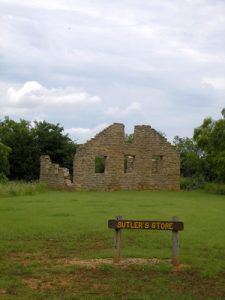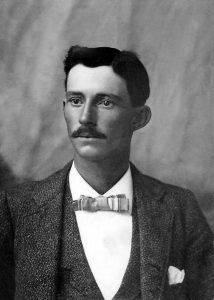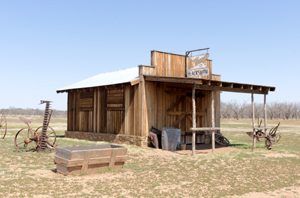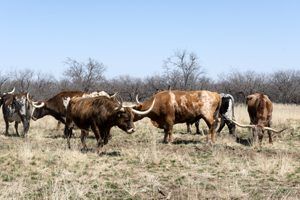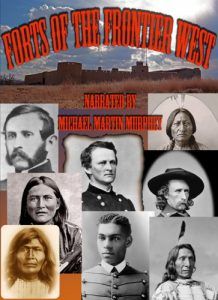Fort Griffin, Texas, was established by the U.S. Cavalry in 1867 in northwestern Shackelford County to protect area settlers from Comanche and Kiowa raids.
Though there is little left of the old fort and even less of the settlement that formed below the bluff, Fort Griffin was one of the wildest places in all of the Old West.
Built on the rolling hills between the West Fork of the Trinity River and Clear Fork of the Brazos River, the area was dangerous as settlers made their way into Texas, conflicting with the Plains Indians who had long called the area their exclusive hunting grounds. Though Forts Belknap, Phantom Hill, and Camp Cooper had already been built in the 1840s, they were not enough to protect new settlers. However, the Civil War interrupted any additional fort building until it was over. Then, afterward, the government began to build forts once again, including Forts Griffin and Richardson.
Work began on Fort Griffin in 1867 when Lieutenant Colonel Samuel arrived with four companies of the Sixth Cavalry on July 31. The outpost, which was first called Camp Wilson, was built upon a hill overlooking the Clear Fork of the Brazos River. Later the name was changed to Fort Griffin, in honor of the late Major General Charles Griffin, Commander of the Texas Army Department and who had initially made the plans for building the new fort.
By the time it was finally complete, the fort would accommodate up to six companies of soldiers and included an administration building, a hospital, officers’ quarters in eleven buildings, numerous barracks, a guardhouse, a bakery, a powder magazine, five storehouses, forage houses, four stables, a laundry, and a workshop.
Almost immediately after the fort was completed, a new settlement began at the bottom of the hill that was first called “The Bottom,” “The Flat,” or “Hidetown,” before it took on the name of the fort. In addition to the honest pioneers who settled the area for legitimate reasons of ranching, agriculture, and commerce, in flooded several ruffians and outlaws.
When more and more people continued to arrive, the Indian attacks increased across northern Texas, keeping the soldiers busy in what was called the Red River Campaign, the battles of which continued until 1874, when the Texas Army defeated the Kiowa and Comanche at Palo Duro Canyon.
In the meantime, the settlement below the hill was bustling with buffalo hunters, businessmen, cowboys, outlaws, gamblers, gunfighters, and “painted ladies,” quickly gaining a reputation for lawlessness.
Some of these many people would later become well-known in the annals of history, including Doc Holliday and Wyatt Earp, who first met in Fort Griffin. Also there were Big Nose Kate; famous lady gambler, Lottie Deno; lawman Pat Garrett, and gunfighter John Wesley Hardin. “Marshaling” the lawless town was outlaw/lawman John M. Larn as sheriff, and his deputy, John Selman who, in the mid-1870s, were working both sides of the law by controlling the local vigilante group known as the Tin Hat Brigade and rustling cattle. John Larn, however, would be killed by those same vigilantes inside his jail in Fort Griffin. On the other hand, Selman quickly disappeared and almost two decades later would kill John Wesley Hardin. During these lawless times, the settlement was so decadent that it was labeled “Babylon on the Brazos.”
In fact, in 1874, the place was so bad that the fort commander placed the town under its control, declaring martial law and forcing many undesirable residents to leave. The town remained under the army’s control until Shackelford County was officially formed later in the year. When the fort was built, and the town below it sprang up, it was part of Jack County. However, while the town was boasting its bawdy ways in the extreme, there were also several law-abiding citizens in the area who wanted to form a new county. Early in 1874, they petitioned the Jack County Court to form their own county. In September, permission was granted, and the new county was called Shackelford in honor of Dr. Jack Shackelford, a Texas revolutionary hero. Fort Griffin became the temporary county seat on October 12, 1874.
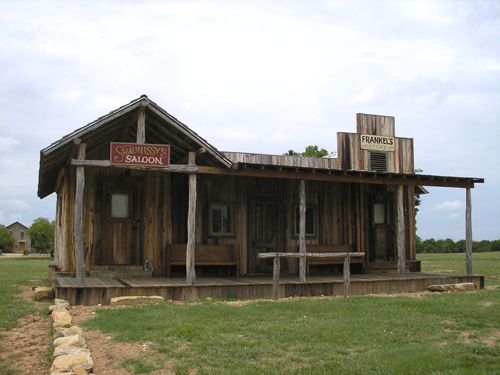
At Shaunissy’s Saloon in Fort Griffin, Wyatt Earp first met Doc Holliday. Today, the saloon has been recreated on top of its old foundation, by Kathy Alexander.
But those law-abiding citizens weren’t satisfied with having Fort Griffin, with its immoral reputation, as their county seat. They quickly gathered together and proposed a brand new town in the center of the county to serve as the permanent county seat. On November 8, 1874, area residents voted to establish the new town of Albany to serve the people of the new county.
Though disappointed at the loss of its county seat status, Fort Griffin continued to bustle, serving as a significant supply source for buffalo hunters from 1874 through 1877 and a stop off for the many cowboys herding cattle up the Western Trail to the Dodge City, Kansas railheads. Businesses of all kinds sprouted up to meet the growing population’s needs, which included numerous stores, saloons, and restaurants. A newspaper called the Fort Griffin Echo was published from 1879 to 1882, and the town even sported an academy for several years. At its height, Fort Griffin had a permanent population of about 1,000 and an estimated transient population of nearly twice that.
However, by the late 1870s, the buffalo on the plains were beginning to dwindle, reducing the many buffalo hunters that called the Fort Griffin home. Vital to the town’s economy, businesses began to suffer and soon packed up and moved to the new town of Albany.
In 1881, two events would spell the final death blows for the town of Fort Griffin. By this time, the Indians of the area had been pushed westward or placed on reservations, and the fort’s soldiers were no longer needed. After 14 years of guarding the area population, the U.S. flag at the fort was lowered for the last time on May 31.
That same year, the Texas Central Railroad was pushing through the region, and Fort Griffin was working desperately to entice them through their city. However, the citizens of nearby Albany raised $50,000 to lure them through their town.
The small town survived for several years, gradually diminishing in size. By the 1940s, the school was consolidated with Albany’s, and a short time later, the post office closed.
Today, only a couple of original buildings are left at the townsite, but several “new” ones have been reconstructed over original foundations. What’s left of this once-thriving town is situated on the Collins Creek Ranch, a wildlife habitat, working ranch, and commercial hunting property. Though privately owned, its owners do allow visitors on the property to view what’s left of this once lawless place.
The fort itself was preserved for years as the Fort Griffin State Historical Park; however, on January 1, 2008, the site was transferred to the Texas Historical Commission. The 506-acre park features the partially restored ruins of old Fort Griffin on the bluff overlooking the old townsite and the Clear Fork of the Brazos River Valley. Several buildings remain, including the mess hall, barracks, administration building, powder magazine, and the restored bakery. Other remnants include a hand-dug well, cistern, numerous foundations, and a rock chimney. The small soldiers’ barrack buildings have been recreated. A portion of the official Texas Longhorn herd resides in the park that also provides camping, hiking, fishing, and picnicking.
With the Texas Historical Commission now operating the site, a few changes are currently being made, including clearing the mesquite trees and cactus from the fort, as these are not historically accurate. This vegetation came up the trail with the longhorns. The Visitor’s Center will also be expanded, and there are hopes that archaeological digs might be conducted in the future.
The site is open daily year-round. Fort Griffin is located on the Texas Forts Trail on U. S. Highway 283, about 15 miles northeast of Albany, Texas.
Contact Information:
Fort Griffin State Historic Site
1701 North U.S. Highway 283
Albany, Texas 76430
325-762-3592
© Kathy Alexander/Legends of America, updated February 2022.
See our Texas Forts Photo Gallery HERE
Also See:

